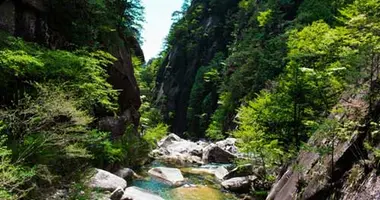Yume no Shima Park Tokyo
Yume no Shima Tokyo: read a detailed sightseeing guide to Yume no Shima ('Dream Island') Park, in Koto Ward, Tokyo.
Yume no Shima ('Dream Island')
Yume no Shima ('Dream Island') 夢の島
Situated in Tokyo's industrial Koto ward bordering Tokyo Harbor, Yume no Shima Koen is an area of green space in a landscape of huge blank-faced warehouses between which runs an constant convoy of trucks, cars and vans.
Yume no Shima Koen is located near Tokyo's driver's license center in Koto ward.

Yume no Shima began life as a landfill and dumping ground, but was rescued from this poor fate in 1972 when it was decided to make the area into a park.
Yume no Shima is now a verdant space covered mainly with eucalyptus trees and enjoyed by strollers, joggers, sketchers, picnickers, sunbathers, and anyone else seeking refuge from the bustle of Tokyo's crowded streets. Between the Park - reached by a bridge - and the mainland is a yacht marina.
The most conspicuous feature of Yume no Shima Park is the Yume no Shima Tropical Greenhouse Dome.
Made up of three domes, the Yume no Shima Tropical Greenhouse Dome features fern and forest in A Dome (complete with waterfall), an archetypal tropical village in B Dome, and the fauna of the Ogasawara Islands, a tropical Pacific archipelago 1000km south-south-east of Tokyo (and officially part of Tokyo) in C Dome. The subtropical Ogasawara Islands are UNESCO World Heritage listed as natural sites.
Being Japan, there is an Exhibition Hall full of interactive gadgets in Yume no Shima Tropical Greenhouse Dome displaying the marvels of fauna, a Visual Hall for video-based education, and an Exhibition Hall that focuses on a succession of different themes.
An exhibit particularly worth seeing is the carnivorous plant room: a small greenhouse full of insect-eating plants, slowly and silently digesting the beetles, ants and other bugs still visible if you peer into the elegant fluted bags that dangle below them.
(Yume no Shima Tropical Greenhouse Dome is open 9.30am-4pm every day except Monday and between December 29th and January 3rd. Adults 200 yen, junior high students 100 yen, elementary school pupils, free. English pamphlet available.)

Five minutes walk from the Dome is a rather less conspicuous institution, the Daigo Fururyu Maru Exhibition Hall.
The Daigo Fururyu Maru Exhibition Hall houses the unfortunate Japanese fishing boat that was bombarded with lethal doses of radiation in 1954 when the US tested the hydrogen bomb 'Bravo' on Bikini Atoll in the Pacific Ocean - in spite of the ship being 60km outside the prohibited zone for the test.
Almost 1000 times more powerful than the Hiroshima and Nagasaki bombs, the Bravo test bombing destroyed the health of the Japanese crew - burning many of them horribly - and eventually ended many of their lives prematurely.
The ship is therefore a symbol of the anti-nuclear testing movement in Japan. It is very impressively housed in an almost church-like structure and is accompanied by informative and often saddening displays of the events.
(The Daigo Fururyu Maru Exhibition Hall is open 9.30am-4pm every day except Monday.
Admission free. English pamphlet available for 100 yen.)
BumB

Yume no Shima Park is also home to the massive, superbly equipped but amusingy named 'BumB' (that's 'Ass' with a B on the end, for American readers!), or, the Tokyo Sport and Cultural Center, with an arena, a futsal ground, heated pool and gym; performance and educational facilities; accommodation; and public spaces such as a restaurant, 'Youth Square' and Kids' Room.
Besides these the Park also boasts a huge multi-purpose colosseum as well as a baseball ground.
Yume no Shima Access
Yume no Shima Park is 10 minutes walk from Shin Kiba station on the JR Keiyo line or the Yurakucho subway line. Also accessible from Toyocho station on the Tozai subway line by taking the bus from 'Toyocho' bus stop to 'Yume no Shima' bus stop.
Yume no Shima Park is a 5-minute walk from the bus stop.
Getting Around in Tokyo
- The circular JR Yamanote Line connects with most major Tokyo stations.
- If you are staying in Tokyo for any length of time consider buying a subway pass.
- trains and buses stop operating in the city between midnight and 6am.






























